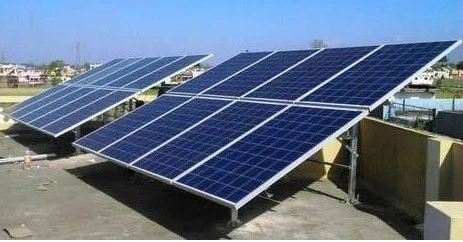An on-grid rooftop solar power plant, also known as a grid-tied or grid-connected solar system, is a solar energy system that is connected to the local utility grid. It generates electricity from solar panels installed on the rooftop of a building and feeds the excess power back into the grid. Below are the complete details of such a system:
Components of an On-Grid Rooftop Solar Power Plant
1. Solar Panels (Photovoltaic Modules):
- These are the primary components that convert sunlight into direct current (DC) electricity.
- Made of silicon cells, they are available in monocrystalline, polycrystalline, or thin-film variants.
- Efficiency ranges from 15% to 23%.
2. Inverter:
- Converts the DC electricity generated by the solar panels into alternating current (AC) electricity, which is used by household appliances and the grid.
- Types include string inverters, microinverters, and hybrid inverters.
3. Mounting Structure:
- Supports the solar panels and ensures they are angled correctly to maximize sunlight exposure.
- Made of galvanized steel or aluminium to withstand weather conditions.
4. Bi-Directional Meter:
- Measures the electricity consumed from the grid and the excess electricity fed back into the grid.
- Enables net metering, where users are credited for the surplus energy they supply.
5. AC/DC Cables and Connectors:
- Used to connect the solar panels, inverter, and grid.
- Ensure efficient transmission of electricity.
6. Distribution Board:
- Distributes the electricity generated by the solar system to the building's electrical circuits.
7. Protection Devices:
- Include surge protectors, circuit breakers, and disconnect switches to ensure safety and prevent damage to the system.
Working Principle
1. Solar panels absorb sunlight and generate DC electricity.
2. The inverter converts DC electricity into AC electricity.
3. The AC electricity is used to power the building's electrical appliances.
4. Excess electricity is fed into the grid through the bi-directional meter.
5. During nighttime or cloudy days, electricity is drawn from the grid.
Additional information
Advantages of On-Grid Rooftop Solar Power Plants
1. Cost-Effective: Lower upfront
costs compared to off-grid systems due to the absence of batteries.
2. Net Metering: Earn credits for
excess electricity fed into the grid.
3. Environmentally Friendly: Reduces carbon footprint by generating clean energy.
4. Low Maintenance: Fewer
components (no batteries) mean lower maintenance requirements.
5. Scalable: Systems can be expanded as energy needs grow.
Disadvantages
1. Grid Dependency: Does not work
during power outages (for safety reasons).
2. No Energy Storage: Excess
energy is sent to the grid instead of being stored for later use.
Applications
- Residential buildings
- Commercial establishments
(offices, malls, factories)
- Educational institutions
- Government buildings
Photograph of an On-Grid Rooftop Solar Power Plant
Below is a description of a typical
setup since I cannot provide actual photographs:
Rooftop Layout: Solar panels
are mounted on the rooftop at an optimal angle (usually 15° to 30° depending on
the location).
Inverter Placement: The
inverter is installed near the main electrical panel for easy connection.
Meter Installation: The
bi-directional meter is placed near the utility meter.
For actual photographs, you can search online or visit solar installation company websites.
Cost and Payback Period
Cost: Approximately $1,000 to
$1,500 per kW (varies by location and system size).
Payback Period: Typically 5 to 7 years, depending on electricity rates and solar incentives.
Government Incentives
Many countries offer subsidies, tax credits, or feed-in tariffs to promote rooftop solar installations. For example:PM SuryagharIn India, the Ministry of New and Renewable Energy (MNRE) provides subsidies.



.webp)

